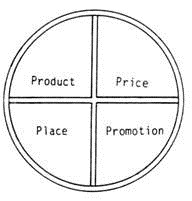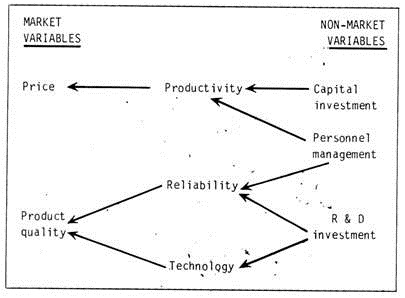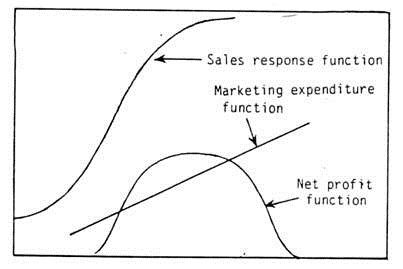In this article we will discuss about:- 1. Definition of Marketing Mix 2. Elements of Marketing Mix 3. Market and Marketing Forces Governing It.
Definition of Marketing Mix:
Some “definitions” of marketing mix are given below:
1. “Marketing mix refers to the amounts and kinds of marketing variables the firm is using at a particular time.” [According to Philip Kotler]
2. “The marketing mix refers to the apportionment of the effort, the combination, the designing and integration of the elements of marketing into a programme or mix which on the basis of an appraisal of the market force will best achieve the objectives of an enterprise at a given time.” [Prof. N.H. Borden]
3. “Marketing mix is the combination of the four inputs which constitute the core of a company’s marketing system — the product, the price structure, the promotional activities, and the distribution system (place).” [Stanton]
Thus, the term marketing mix refers to a combination of marketing decisions which are aimed at stimulating sales and constitutes a firm’s marketing system in a global sense.
It denotes and consists of a well-designed plan that analyses the important forces having direct linkage with the firm’s marketing operations and that outlines and implements policies relating to the firm’s marketing programmes through co-ordination of available resources such as sales promotion, advertising, personal sales, service, distribution, etc.
The concept includes “Four P’s” i.e.:
i. right product,
ii. right price,
iii. right promotion, and
iv. right place.
Elements of Marketing Mix:
A product must be such as to satisfy the needs and wants of the consumer. The price of the product must be reasonable so as to enable the consumer to pay for the product. If it is exorbitant, most of the consumers reject it. Also the promotion such as advertising and personal selling must be right without exaggerating the advantages of the product. And place means transportation and channels of distribution.
These four P’s are now widely discussed by the marketing executives because any one variable of than is of no use. Every element of the marketing mix must be planned with demographic profile in mind. The product design, price, advertising media, sales promotion tools and distribution channels will often be different depending upon whether the target market is young, and so on.
Marketing plan must be based on the characteristics of the best target market or markets for a particular product or service. The market planners, thus, lock first at demographic characteristics since these are usually more available, reliable, and actionable than other types of characteristics.
Changes in one or more demographic characteristics of the population often prompt a business firm or an entrepreneur to offer some new product or service aimed at the changing segment.
The marketing manager in the interest of his business firm has to arrange and co-ordinate the marketing activities in such a way that would advance harmonious development of each of the above four P’s.
The elemental activities comprising the marketing mix are explained below:
1. Product Planning:
It would include policies and procedures relating to:
(a) Product lines to be offered, i.e. quality, design, etc.;
(b) Markets to sell, i.e. to whom, where, when, and in what quantity;
(c) New product policy, i.e. research and development programmes.
2. Pricing:
It would include policies and procedures relating to:
(a) Price levels to adopt;
(b) Specific prices to adopt;
(c) Price policy, i.e. one price or varying price, price maintenance, etc.
3. Branding:
It would include policies and procedures relating to:
(a) Selection of trade mark;
(b) Brand policy, i.e. individualised or family brand;
(c) Sale under private level or unbranded.
4. Channels of Distribution:
It would include policies and procedures relating to:
(a) Channels to use between plant and consumer;
(b) Degree of selectivity among wholesalers and retailers;
(c) Efforts to gain co-operation of the trade.
5. Personal Selling:
It would include policies and procedures relating to the burden to be placed on personal selling and the methods to be used in:
(a) Manufacturer’s organisation;
(b) Wholesale segment of the trade;
(c) Retail segment of the trade.
6. Advertising:
It would include policies and procedures relating to:
(a) Amount to be spent on advertising;
(b) Copy platform to adept, namely,
(i) Product image desired;
(ii) Corporate image desired; and
(c) Mix of advertising to the trade, through the trade, and to the consumers.
7. Promotion:
It would include policies and procedures relating to:
(a) Burden to place on special selling plans or devices directed at or through the trade;
(b) Form of these devices for consumer promotions and trade promotions.
8. Packaging:
It would include policies and procedures relating to:
(a) Formulation of package and label.
9. Display:
It would include policies and procedures relating to:
(a) Burden to be put on displays to help in effecting sales; and
(b) Methods to adopt to secure display.
10. Service:
It would include policies and procedures relating to:
(a) Providing after-sales-service as needed.
11. Physical Handling:
It would include policies and procedures relating to:
(a) Warehousing,
(b) Transporting, and
(c) Inventories.
12. Fact Finding and Analysis:
It would include policies and procedure relating to securing, analysis, and the use of facts in marketing operations.
Market and Marketing Forces Governing Marketing Mix:
Before arriving at the optimum marketing mix, the management of business enterprise should carefully and systematically examine the factors that influence the market and marketing practices. Some of them are internal to the firm while there are certain factors external to the film.
According to Prof. Stanton, marketing mix is a controllable factor in that the management can control them by changing them appropriately, whereas the external factors such as demography, economic growth, technological changes and consumer needs and wants cannot be controlled.
He opines that marketing mix is influenced by market opportunities and target market, and that the marketing plan is prepared to reach the target market so that the customer satisfaction is attained. It starts and ends with the customer.
It is prepared after marketing strategy is formulated having regard for the resources, strengths of management, and tiring. Ideally optimum marketing mix must be formulated. It must enable the company to reach the target market and to achieve marketing goals.
Specifically, marketing mix should focus on:
1. Product line and product mix
2. Stages of product-life cycle
3. Channels of distribution
4. Advertising policy and strategy
5. Personal selling and sales promotion
6. Pricing policy, strategy and practices.
All this involves detailed analysis of various intricacies and judgement. Above all, the competitor’s policies and strategies, the industry structure, government regulation of monopoly, governmental control over prices, government policies on imports and exports and the future trends are needed to be analytically studied.
According to Philip Kotler, marketing mix interactions need to be watched from market variables as shown in the following diagram:
As marketing expenditure increases for developing markets, sales also increase and this aids in reaching target market. Therefore, there must be realistic marketing budgeting. Marketer must understand the relationship between the marketing mix expenditure and their sales and profit consequences. These relations are captured in a profit equation and sales equation.
As market expenditure increases the sales response will be more favourable as shown in the diagram below:
Without going into the complex mathematics involved in the above diagram, the management in general and the marketing management in particular need to reflect on the main conclusions and how target market and profit goal can be reached by optimal marketing mix.
Market Factors:
The market factors which constitute uncontrollable elements and affect the marketing activities and the marketing mix of a company are as follows:-
1. Consumers:
The behaviour of the consumers with respect to their needs, tastes and preferences affect the demand of the products. Their buying habits, living standards, purchasing power, social status, and outlook for fashion have a profound effect on the market.
2. Competition:
The prevailing competitive conditions as revealed and influenced by the size/strength/number of competitors, indirect competition from substitute products, demand-supply relationship, industry’s offers to customer for product choices, price and non-price factors, techno- commercial and social characteristics in relation to demand and supply position, and the competitors’ strategy and policy affect the market and thereby the marketing mix.
3. Distribution:
The behaviour and attitudes of various distributing agencies e.g. wholesalers and retailers, the’ customer-distributor interactions about the product characteristics, the transport systems, and the various forms and channels of distribution system largely determine the market as these systems provide the means to reach the dealers, customers, and consumers.
4. Government:
Now-a-days, the Government exercises specific controls over various marketing activities by means of regulations as regards products, pricing, quality, specification, packaging, restrictive trade practices, weights and measures, labelling, advertising, and sales promotion. In the design of a marketing mix, the marketing management should think and appraise the possible Government intervention en these issues.


